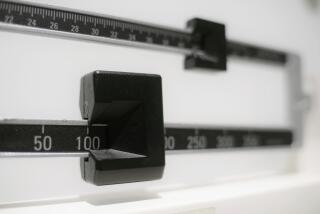The Real Skinny on Fat
- Share via
Don’t add another half-hour to your Stairmaster time just yet. As health-conscious Southern Californians sweated out trying to calculate their “body mass index” Wednesday after a report was released the day before claiming to show that overweight Americans are now in the majority, the National Center for Health Statistics sheepishly backed away from the data that jolted so many Americans out of their recliners.
Remarks by a center official at a conference on obesity were either misinterpreted or misleading, said Jeff Lancashire, a spokesman for the center, which is an arm of the federal government. Lancashire said the center instead stands by its 1994 report that found one in three American adults were overweight--not more than half.
The confusion stemmed from a speech Tuesday by Katherine Flegal, a researcher for the National Health and Nutrition Examination Survey--which provides data to the center on this issue--before the North American Assn. for the Study of Obesity. Flegal told the group that according to center statistics, more than half of American adults had a body mass index (BMI) higher than 25.
That’s true, but 25 turns out not to be the magic number when it comes to measuring obesity, said Lancashire.
“Our standard is 27.8 for men and 27.3 for women,” said a somewhat weary-sounding Lancashire, whose office has been swamped with calls since the reports broke about Flegal’s speech.
That’s a big difference. A 6-foot man would be considered over the limit at anything more than 185 pounds if the maximum healthy BMI is 25. With a BMI of 27.8, the threshold rises to about 206 pounds.
According to charts that the center uses in addition to BMI, a man of that height would be at the upper end of the “healthy weight” range at 185 and in the “moderate overweight” range at 206.
Center officials have been unable to reach Flegal because by the time they found out about her speech, she was on vacation in parts unknown, Lancashire said.
“She was with her family, and they made a getaway right after the presentation,” he said. “I don’t think she had any idea what was going to take place.”
Lancashire said the institute has not been able to obtain a copy of her remarks, but he speculated that she mentioned the 25 BMI standard because it’s the one used by the World Health Organization.
“She was going on the international figure--maybe because it was an international conference,” he said.
He said Flegal may not have known reporters were present for her talk. “But they sure were,” he said. “We started to get calls right away.
“We didn’t even know what they were talking about until someone faxed us an [Associated Press] story.”
But the news left plenty of folks calculating.
In Woodland Hills on Wednesday, a survey found many people surprised to learn that their BMI is well within acceptable weight guidelines.
“Oh my God!” squealed Debbie Goldstein in delight when she learned her BMI is 22. Toting cheeseburger, fries and Coke out of a Fatburger stand, the 37-year-old had just explained that she considers herself 10 pounds overweight.
Chip Hord, 31, was also at the Fatburger, dining on two chicken sandwiches, no mayo, no fries.
“Not bad,” he said of his BMI of 24. “I exercise by running and try to eat a pretty good diet,” he added in his North Carolina drawl. “Weight control is not too hard if you make the right choices.”
Manny Ilagan, a 38-year-old security guard from Arleta, said his doctor had just put him on a strict diet with orders to lose at least 20 pounds. “I need to eat less rice and fat,” said the 5-foot-5, 230-pound Ilagan, whose BMI is 38, well above either standard.
At the Total Woman fitness center, manager Julie Lindsey proudly figured her BMI at 22. But she said she works hard at it, “watching what I eat and having regular exercise.”
At lunchtime in Santa Monica, the fragrance of shish kebab, stir-fry and sauce-slathered pasta hung heavily in the air at the Santa Monica Place food court. For some, the culinary sights were evidence of Americans’ permanent weight problem.
“Take a look around here, at all the temptations in one place,” said Frank Fordyce, 56, seated at a table. “There’s too much junk food. We make overeating and eating wrong so attractive.”
“He’s right,” nodded 46-year-old Catherine Kelly, on a break from her sales job. “I was planning to go home and eat, but you come down here and you see the Chinese food, the deli--it’s like a kid in the candy store. What should I have today?”
Lunchers like Fordyce and Kelly attributed the bloated number of overweight Americans to good old-fashioned indulgence.
“We’re just spoiled. Our portions are too big,” said Kelly, pointing to the remnants of her pastrami sandwich. “In Europe, they’d give you half this much. But if I went over to the deli tomorrow and he gave me a smaller portion, I’d think I was getting cheated.”
Other lunch-goers said the increase in weight problems is driven by a fast-paced culture in which people turn to food for refuge.
“In the past 30 years, there have been so many changes far too rapidly, and when they happen so quickly, we don’t have time to believe them or absorb them,” said retired nurse Charlotte Heren, 76.
There just doesn’t seem to be time to eat well, she said.
“I think a lot of it can be attributed to mothers working,” said Jane Clotiaux, a 72-year-old retired shop manager, finishing her stir-fry. “There’s not enough time in the day for mothers to prepare nutritious food, and kids start out dependent on junk food.”
“People work too much and are stuck behind their desks,” said Dan Lion, a 34-year-old salesman, as he and his lunch companions dug into the salads they ordered for lunch. “I heard the average lunch hour now is 40 minutes--people just wolf down their food.”
Across the table, John Siczewicz nodded.
“I just sit behind my desk at lunch,” said 34-year-old Siczewicz, who produces special effects for film and television. “I think it depends on what age you are. I was very adamant about going to the gym, but once I started getting busier with my life, my house--it just doesn’t happen.”
But maybe that’s not so wrong, others said.
“When I was a bartender, a woman came in and ordered a rum and Diet Coke. Get out of here! That’s the way we fool ourselves,” Fordyce said, shaking his head.
“This country is great, but this weight thing is way out of hand,” Kelly said. “People don’t get chosen for jobs because they’re overweight. A girl is afraid to go to a party because she doesn’t like what she looks like. They’ve made it into a crime to be overweight.”
She paused.
“I still would like to lose 50 pounds, but I’m not going to kill myself over it.”
(BEGIN TEXT OF INFOBOX / INFOGRAPHIC)
How to Figure Body Mass Index
Federal researchers believe that a body mass index over 27.8 for men and 27.3 for women may be too high. Here’s how to figure yours:
1. First, multiply your weight in pounds by .45 to get kilograms.
2. Next, convert your height to inches.
3. Multiply inches by .0254 to get meters.
4. Multiply the number of meters by itself.
5. Divide the kilograms (No.1) by the squared meters (No.4).
Your answer will probably be in the 20s or low 30s. It is your body mass index.
Source: Associated Press Times correspondent Matea Gold contributed to this story.
More to Read
Sign up for Essential California
The most important California stories and recommendations in your inbox every morning.
You may occasionally receive promotional content from the Los Angeles Times.











